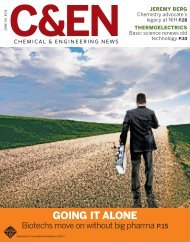Chemical & Engineering News Digital Edition ... - IMM@BUCT
Chemical & Engineering News Digital Edition ... - IMM@BUCT
Chemical & Engineering News Digital Edition ... - IMM@BUCT
Create successful ePaper yourself
Turn your PDF publications into a flip-book with our unique Google optimized e-Paper software.
SCIENCE & TECHNOLOGY<br />
GARY MEEK/GEORGIA TECH<br />
ACADEMIC R&D<br />
SPENDING TRENDS<br />
Spending on chemical research and on science and<br />
engineering as a whole ROSE A MODERATE 4.3% in 2006<br />
SOPHIE L. ROVNER, C&EN WASHINGTON<br />
ENTHUSIASM FOR INVESTMENT in<br />
research and development in academe appears<br />
to be waning. Funding continued to<br />
expand in fiscal 2006, the most recent year<br />
for which data are available from the National<br />
Science Foundation, but the outlook<br />
is troubling, particularly in light of the current<br />
economic climate.<br />
Overall university and college spending<br />
on science and engineering R&D rose<br />
just 4.3% to $47.8 billion in 2006. That year<br />
marked the fourth in a row in which spending<br />
rose less than the prior year. Average<br />
annual growth from 1996 to 2006 was 7.6%,<br />
but that strong performance owed a lot to<br />
the 9.1 to 10.9% annual increases that occurred<br />
in the first four years of the current<br />
decade. Growth slipped to 7.9% in 2004<br />
and 5.9% the following year. The 2006 expansion<br />
was the smallest since 1996.<br />
Removing inflation from the statistics<br />
shows that total R&D spending by universities<br />
and colleges edged up 1.0% in terms of<br />
constant dollars between 2005 and 2006.<br />
From 1996 to 2006, spending grew a total<br />
of 67.2% in constant dollars, compared<br />
with 107.2% in current dollars.<br />
For many years, basic research has<br />
soaked up three-fourths of the total outlay<br />
on academic R&D. In 2006, $36.0 billion<br />
was funneled into basic research, a rise of<br />
4.9% in current dollars versus 2005. That<br />
growth pales beside the robust 8.8% annual<br />
average increase during the prior decade.<br />
Applied R&D spending rose a mere 2.5%<br />
to $11.7 billion in 2006, well off the 10-year<br />
annual average increase of 4.5%.<br />
Much of academe’s total R&D budget<br />
is supplied by the federal government. In<br />
2006, the federal sector’s $30.0 billion outlay—which<br />
represented an increase of 2.9%<br />
over the prior year—accounted for 62.9%<br />
of total funding. Institutions provided just<br />
19.0% of the total, followed by state and<br />
local governments, with a 6.3% stake, and<br />
industry, with a 5.1% share.<br />
Each year, science absorbs far more academic<br />
R&D dollars than does engineering,<br />
and 2006 was no different, with 85.2% of<br />
the budget directed to science. The $40.7<br />
TUBULAR <strong>Chemical</strong><br />
engineers Sankar<br />
Nair (right) and<br />
Suchitra Konduri of<br />
Georgia Tech—one of<br />
the top investors in<br />
chemical engineering<br />
R&D—study<br />
nanotubes made<br />
from metal oxides.<br />
billion investment<br />
in science was<br />
4.2% higher than<br />
in 2005. The largest<br />
sector by far<br />
continued to be the<br />
life sciences, accounting<br />
for 60.4%<br />
of the total academic<br />
R&D budget.<br />
Spending on the<br />
sector rose 4.4% to $28.8 billion in 2006.<br />
The physical sciences, among them<br />
chemistry, physics, and astronomy, were<br />
allotted just 8.0% of total R&D funding<br />
in 2006. Academe invested $3.8 billion<br />
in this category, an increase of 3.2% over<br />
2005. Investment in chemistry rose 4.3%<br />
to $1.4 billion in 2006. That growth maintained<br />
chemistry’s share at 3.0% of the<br />
total R&D budget.<br />
On a constant-dollar basis, chemistry<br />
spending rose a mere 1.0% between 2005<br />
and 2006. From 1996 to 2006, chemical<br />
R&D spending grew a total of 43.3% in<br />
constant dollars, compared with 77.6% in<br />
current dollars.<br />
From 2005 to 2006, engineering spending<br />
grew at a faster rate than science spending,<br />
rising 5.0% in current dollars to reach<br />
$7.1 billion. <strong>Engineering</strong>’s 14.8% portion<br />
of the total budget was a smidgeon higher<br />
than the prior year’s share.<br />
Materials engineering spending, which<br />
accounted for 1.3% of the total R&D budget<br />
in 2006, grew 5.2% compared with the previous<br />
year to reach $644 million. <strong>Chemical</strong><br />
engineering beat that growth rate, rising<br />
a healthy 8.1% to $547 million, for a 1.1%<br />
share of the total budget.<br />
FEDERAL SUPPORT for chemical engineering<br />
rose more than usual. Between<br />
2005 and 2006, investment in the sector<br />
expanded 6.1% to $313 million. Federally<br />
financed materials engineering spending<br />
grew 4.9% to $387 million. Federal investment<br />
in engineering as a whole rose only<br />
2.7% to $4.2 billion in 2006.<br />
Federal support for science R&D in<br />
academe increased just 2.9% to $25.8 billion<br />
between 2005 and 2006. Within the<br />
science sector, the life sciences gained 3.2%<br />
in funding to reach $18.3 billion in 2006.<br />
Chemistry’s pickings were slim, with federal<br />
R&D backing edging up just 2.6% to<br />
$974 million.<br />
MORE ONLINE<br />
For tables on postdocs and grad students; the source of academic funds; and spending on basic and<br />
applied R&D, chemical engineering, and research equipment, visit www.cen-online.org.<br />
WWW.CEN-ONLINE.ORG 31 NOVEMBER 3, 2008

















